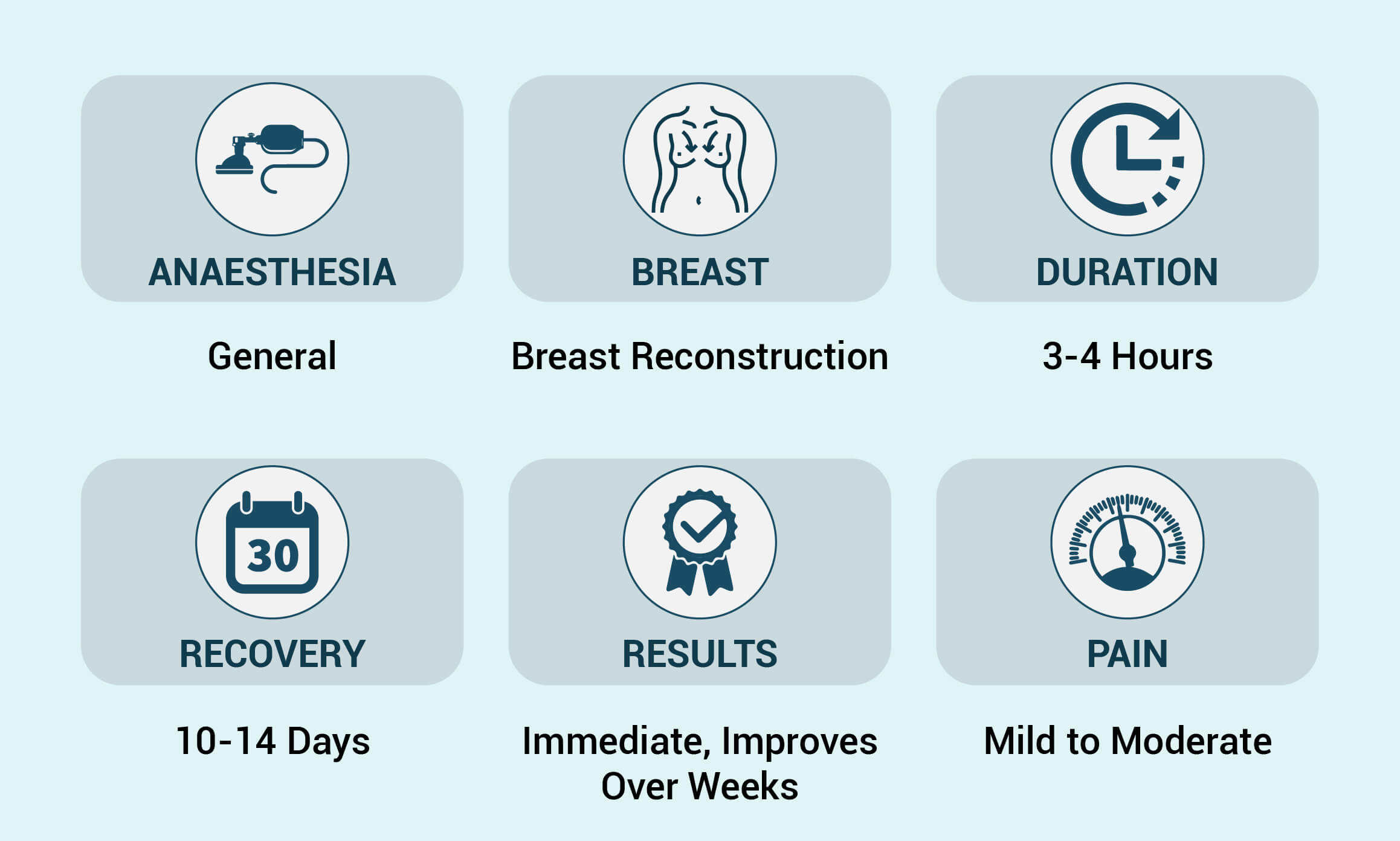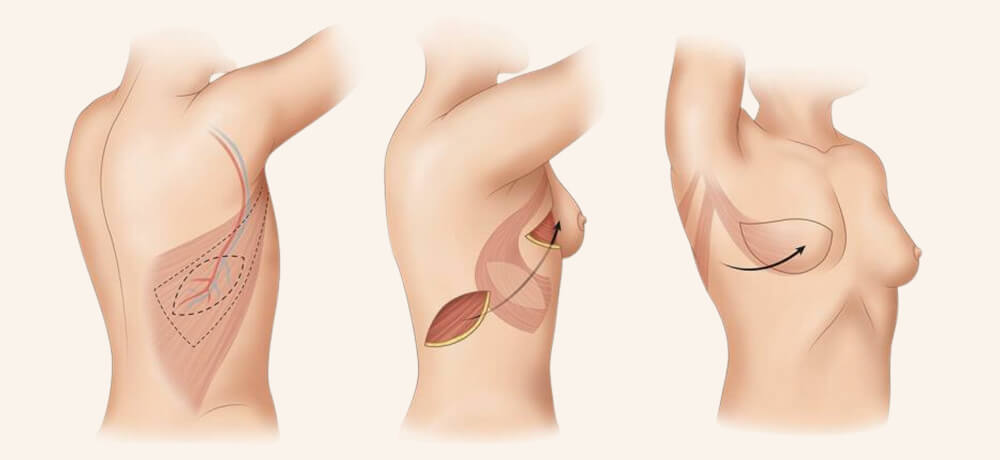Breast Reconstruction Surgery in Mumbai
Breast Onco Surgeon In Mumbai
In breast reconstruction, artificial implants and flaps are used to reconstruct a lost breast so it appears natural in shape, size, and symmetry. In recent years, breast cancer has become the most common form of cancer diagnosis among women. Among the factors that cause breast cancer in women are a mutation of the genes, obesity, radiation, use of alcohol, and hormone therapy.

What is Breast Reconstruction?

Breast reconstruction procedure or breast cancer reconstruction surgery is the re-building of a breast, usually in women following surgical removal of a part or cull breast tissue. It is a type of breast plastic surgery as it involves the use of autologous tissue or prosthetic material to construct a natural-looking breast.Often this includes the reformation of a natural-looking areola and nipple. This procedure involves the use of implants or tissue taken from other parts of the woman’s body.
Breast Reconstruction Options: What Are They?
The types and stages of breast cancer that you are dealing with determine the options you have for breast reconstruction. Although women who have already undergone a mastectomy have fewer options, they can still benefit greatly from reconstruction surgery performed by an experienced breast cancer surgeon.
There are more options available to women who require breast reconstruction but have not yet undergone mastectomy, such as implant reconstruction or tissue flap surgery. Therefore, you should meet with an experienced breast reconstruction specialist prior to scheduling mastectomy surgery to discuss and understand all your options.
Our team at The Plastic Surgeons in Mumbai is fortunate to have Dr. Vinay Jacob , the leading breast specialist in Mumbai . Dr. Jacob , a pioneer in breast reconstruction, has devised a unique technique called direct-to-implant reconstruction, which allows patients to undergo breast reconstruction at the same time as mastectomy. As a result, patients do not have to undergo two separate surgeries and the results are among the most effective in the world.
There are several types of breast surgery that may be used to treat breast cancer, including:
Lumpectomy :
This procedure involves removing the cancerous tumor and a small amount of surrounding tissue.
Mastectomy :
This procedure involves removing the entire breast. There are several types of mastectomy, including:
Total mastectomy:The entire breast is removed, including the nipple, areola, and skin.
Modified radical mastectomy:The entire breast is removed, as well as some of the lymph nodes under the arm.
Radical mastectomy:The entire breast, chest muscles, and lymph nodes under the arm are removed. This procedure is not commonly performed.
Breast reconstruction:
After a mastectomy, some people may choose to have breast reconstruction surgery to rebuild the shape and appearance of the breast. There are several different techniques that can be used to reconstruct the breast, including using implants or using tissue from another part of the body.
Our Team is able to offer the complete range of reconstructive techniques which are used in breast reconstruction, including :
Immediate and Delayed Reconstructions:
An immediate reconstruction is performed at the time of the mastectomy or cancer removal. The advantage of this technique is that it allows the natural breast to be preserved. It also means that the woman never experiences life without a breast.
Not all women are suitable for an immediate reconstruction. A reconstruction performed at a later time (delayed reconstruction) i.e. breast reconstruction after radiation can also produce a very natural looking breast. Usually a larger area of needs to be introduced for a delayed procedure, as the natural breast envelope has been reduced at the time of the initial mastectomy.
Autologous Reconstruction:
The term autologous simply means the use of the patient’s own tissues for the reconstruction. Many options are available but the commonest used are:
The lower abdominal tissue or a TRAM flap (Transverse Rectus Abdominis Myocutaneous flap). In a TRAM procedure, a portion of the abdomen tissue group, including , adipose tissues, minor muscles and connective tissues, is taken from the patient’s abdomen and transplanted onto the breast site. This is a situation where it is better to be larger, and have an excess of tissue in this area. These procedures are preferred by some breast cancer patients because they result in an abdominoplasty (tummy tuck), and allow the breast to be reconstructed with one’s own tissues instead of a foreign implant.
This tissue can be transferred as either:
A pedicled flap-the tissue is “swung” into place whilst still attached to the patient’s body or a free tissue transfer which uses the microvascular techniques, the tissue is detached from the abdomen and its blood flow is restored by joining it to a new blood supply on the chest.
The upper back as a latissimus dorsi flap. The and muscle under the arm and extending onto the upper back can be transferred whilst still attached to a blood supply in the armpit (pedicled flap). This is a good technique when the patient has no excess tissue on the abdomen.
Tissue from the upper outer thighs (the “saddlebag” area). This is only used when the above tissues are not available and is transferred as a free flap.
Tissue from the buttock area. The tissue, referred to as the S-GAP flap, is transferred using micro-vascular techniques.
Perforator flap reconstruction is a new technique which uses microvascular techniques, but reduces the potential problems of the donor site (where the flap is taken from) eg. DIEP flaps. The artery and vein supplying the and fat is dissected out. When the tissue is transferred, more of the muscle and fascia from the donor site is preserved. This results in a greater strength and less potential problems at the donor site.
Prosthetic reconstruction also known as breast reconstruction with implants.
The term prosthetic refers to the use of artificial materials for reconstructions. The types of materials and devices used are similar to those used for breast augmentation.
These techniques can be performed as immediate or delayed reconstructions. They may consist of one or two staged operations. Excellent results can be achieved. Prostheses are best avoided in people who have had, or may require radiotherapy. Immediate reconstructive cases may require the use of an initial tissue expander. This is a device that can be serially inflated with saline to increase the volume of the reconstructive breast, and in so doing, will increase the amount of overlying the breast. In single stage or in the second stage of a two stage procedure, the surgeon inserts an implant, beneath a pocket under the pectoralis major muscle of the chest wall.
Direct to Implant ('One-Step') Breast Reconstruction post-mastectomy reconstruction with a direct to implant or a “one-step” approach allows for a single-stage reconstruction of the breast mound in select patients.
This approach is best suited for patients with good preservation of the breast after mastectomy. A permanent implant is inserted immediately following the mastectomy, forgoing the initial placement of a tissue expander and subsequent expansion process.
What it won’t do?
Breast Reconstruction surgery does not significantly change the size of your breast. If you want to look fuller or smaller, you might want to consider either breast augmentation or breast reduction surgery.
Oncoplastic breast surgery
This technique involves the reshaping of the remaining breast tissue after a breast cancer is removed. The breast will be smaller than before the removal of the cancer. This technique may improve the shape of an older or drooping breast. There are many factors which influence what will be the optimum type of reconstruction for you.
Dr. Vinay Jacob and Dr. Giovanna Spinzo have trained in various parts in Europe and are hailed as best breast reconstruction surgeons by top breast onco-surgeons in Mumbai.
 WhatsApp
WhatsApp